Entrepreneurship Assignment: Impact of COVID-19 on SMEs in UK
Question
Task
You are required to write a report on entrepreneurship assignment detailing the application of the proposed innovation in SMEs operating in different sectors in the UK and how the solution could be implemented in a similar company in another city in the EU or International country. You should incorporate the challenges associated with implementing the innovative solution and the expected benefits to all stakeholders.
Answer
Introduction
It is evident herein entrepreneurship assignment that business or service innovation is considered as adding something new to the present process or operations of marketing or making the service. In different cases, organizations must innovate their product or service line as per the demands of the domestic consumers and overseas consumers. This study will concentrate on the business innovation and entrepreneurship of SMEs in the restaurant industry and in medicine and parcel delivery industry and analyse how the online business platform could help them.
Section 1. External Audit
The external audit would be done through three different industries in the UK where SMEs could face opportunities from the problems amidst COVID-19 pandemic. These industries are Goods delivery service, medicine delivery, food and grocery delivery. A nation-wide analysis of the opportunities is listed below;
Goods delivery service:
Lockdowns in the country and advanced merchandise charges add to the problems, which the postal service or fragile goods service providers are rassling with in the pandemic. Various goods ordered online are shipped around the country in separate consignments, in which is acknowledged as parcel trading (Shahmohammadi et al., 2020). It has assisted customers access the products they require in quarantine and also permitted SMEs, specifically small ones in managing financial activities. These kinds of parcels shipped during lockdowns very importantly, however, data existed for the UK cities shows that increase has been dominated through purchases of computers and similar accessories; medical products and leisure goods as games and books (Singh et al., 2020). The problems underlined previously could become an opportunity for the SMEs in this industry through enabling e-payments, signatures, digital certificates as well as online postal capabilities that could help addressing some of these problems make sure that companies could continue works, while maintaining physical distancing measures (Shahmohammadi et al., 2020). Although, minimizing in-person communication while keeping organizations of all sizes functional would remain core priorities for policymakers for the next few years.
Medicine delivery services
With an important development in demands for medicines, attached with an alteration in public behaviours like panic purchasing on the counter painkillers amidst to the pandemic, it is putting heavy pressures on SMEs or small pharmacies (Hussain & Dawoud, 2020). While the demand for online pharmacy delivery could increase among general public, there loyalty and suitability preferences will remain the same. Consumers still considered the location factor as a significant one (46%) for making their medical orders (Wu et al., 2020). They still want the convenient availability hours (32%) weigh over any discount plan offered by any e-medical stores. The problem to small and medium sized medicine outlets mostly has come from cash strapped online big companies and not consumers or other retailers. The use or development of smart online lockers will minimize the delivery experiences of consumers to lower contact and self-service designs (smi-online.co.uk, 2021). Managed by technologies as depth as face recognition as well as voice confirmation these e-lockers could process to quick and contract less checkouts.
Food and grocery delivery services
Among the COVID-19 pandemic and regulation on the temporary closure of restaurants in UK; restaurants-to-customer delivery and platforms-to-customer delivery applications and services have developed interestingly (Kim, 2020). The small and medium sized companies around the country could take this opportunity and develop their own online platform-to-customer food and grocery delivery application. It has been outlined that this pandemic situation could help in boosting the consumer numbers and revenue of certain small companies in this sector (Kim, 2020). It could be said that customers will prefer convenience, delivery time and products’ availability from these local small online food and grocery delivery companies (Kim, 2020). The SMEs should develop or concentrate on developing separate e-delivery platform in their business line and take this opportunity to boost their revenue and market growth.
Pestle analysis of UK Parcel industry
|
Political |
Uk’s courier and postal sector has been liberalized before pandemic so interested businesses could easily include in the sector. |
|
Economic |
The self-lock and drone deliveries are projecting effective financial gain for small companies (Shahmohammadi et al., 2020) |
|
Social |
The customer segment in this sector is different and strong. |
|
Technology |
Currently, using drones and online self-lock parcel deliveries are popular. |
|
Legal |
Normal patent and copyright laws in UK should be followed |
|
Environmental |
Logistics and transportation will be used less thus pollution will be minimized (Shahmohammadi et al., 2020). |
Table 1: External analysis of Parcel sector
Pestle analysis of UK Medicine industry
|
Political |
Pricing pressure on drugs is one of the political pressures for the companies and government rules need to be followed |
|
Economic |
Online activities will minimize the labour costs and other transportation costs for small companies (Hussain & Dawoud, 2020). |
|
Social |
Most of the target consumers will get the better chance to avail and access medicines online |
|
Technological |
Turning to online medicine and other essential deliveries are becoming stable and small businesses should plan their business model in this way (Hussain & Dawoud, 2020). |
|
Legal |
Government regulatory frameworks need to be followed as well. |
|
Environmental |
Development and manufacturing drugs will have low environmental impacts. |
Table 2: External analysis of Medicine sector
Pestle analysis France restaurant industry
|
Political |
The disposable income decline, change in the price rates are the major political factors. |
|
Economic |
Cost of recovering business is sable and online food selling business revenue is growing |
|
Social |
More consumers are engaging into the online food purchasing platforms. This innovative business idea will help the SMEs in this industry to cater to the common needs and problems of consumers who are facing problems with food purchasing and dining outside. |
|
Technological |
Online food delivery operations for small and leading companies in this sector are increasing. |
|
Legal |
Regulatory framework is the same as prior to Covid-19 |
|
Environmental |
Social distancing and recycle products in the food parcels have been used to minimize pollution |
Table 3: External analysis of France restaurant industry
Section 2. Personas (users)
The solution design for users will be divided here in three parts for the three different sectors identified in the United Kingdom. Explanation of the user profile are discussed below;
For the Goods delivery service:
The users in the goods delivery service varies in different cases. There are individual consumers to the different companies that also apply for the goods delivery services. The later types of users include firms, warehouses of companies. Although, it could be said that big sized of goods or materials usually get delivered in these cases. This study will focus on the small companies that could get advantage on the online goods and parcel delivery application or going fully online as the solution proposed earlier (Zhou et al., 2020). In this case, the main users will be business people, individual consumers, family members, students and others. The main age range will be from 18 to 65 age. In this type of consumer profile, consumers include will be related to different jobs and their earning styles will also be different as their needs will be also different (Gunawan, Kusuma & Abdullah, 2020). For this fact, design of the online delivery of goods to the locations they want and the parcel delivery structure will also introduce options for the medium range delivery option with time and cost related factors as well as the fast delivery time and price range.
|
Customer types |
Characteristics |
Age |
|
Business people |
Will need to deliver parcels in an urgent basis |
30-45 |
|
Single consumers |
Will need the delivery services occasionally |
25-35 |
|
Students |
Will need the delivery services occasionally |
18-23 |
|
Family people |
Will need the delivery services occasionally |
35-65 |
Table 4: Consumer profile
(Source: Created by the learner)
For the Medicine delivery services
The online application and medicine delivery services in this industry will target mostly the middle-aged consumers, aged consumers and the family persons (Hussain & Dawoud, 2020). The small and medium range companies should design the interface and delivery terms as per the needs of the consumer profile or range outlined above. A detailed consumer profile is listed below;
|
Customer types |
Characteristics |
Age |
|
Aged people |
Aged people will need convenience, timely accessible and regular medicine delivery and purchasing online. |
Above 65 |
|
Families with children |
Families with children will tend to bulk buying. |
30-45 years old |
|
Families without children |
Family consumer will purchase and ask for delivery of medicines when necessary. |
20-45 years old |
|
Middle-aged consumers |
These types of consumers will purchase and ask for delivery of medicines when necessary. |
35-50 years old |
Table 5: Consumer profile
(Source: Created by the learner)
For the Food and grocery delivery services
For the online food and grocery delivery application in UK industry; the target consumers are families, regular consumers. Under the regular consumers profile, Gen-z buyers, single people would be included. Consumer profile of these target users are listed below;
|
Customer types |
Characteristics |
Age |
|
Families |
Will be interested in buying groceries for a month or could be for two weeks in total. |
Varied families and numbers of people. Generally, would range from age 30-60 years |
|
Gen-z buyers |
More interested in buying and swift delivery of foods than the grocery items. |
18-23 years old |
|
single people |
More interested in buying and swift delivery of foods than the grocery items. |
23-30 years old |
Table 6: Consumer profile
(Source: Created by the learner)
Section 3. Pain points
The pain points will be discussed divided into three kinds of delivery and online business applications in SMEs in three sectors. Pain point are described in adaptation of the solution and influences in UK industry based.
Issues with the persona in Goods delivery service
The extra demands for purchasing online or on the phone is both a good thing and a challenge. However, volume is importantly high, the stress on the system is making delays (Grashuis, Skevas & Segovia, 2020). For instance, Amazon-popular for making around international same-day or next day deliveries on goods-is currently facing delivery slowdowns. As delivery organizations in UK are organizing clinical and family unit items, basic things are currently being offered regarding a long time rather than weeks. Protests regarding packages conveyances to Citizens Advice have trebled since COVID-19 hit, as customers went to online requests. Residents Advice said its shopper administration had gotten three-fold the number of calls about conveyance issues since March contrasted and a similar period a year ago (Grashuis, Skevas & Segovia, 2020). Its site page on bundle conveyance rights has been getting twice the same number of hits this year contrasted and last year (Brignall, 2020). This report rings with the Guardian's own postbag which has also recorded a major hop in protests about bundles being conveyed to some unacceptable location, and the stores wrongly declining to discount the client.
Issues with the persona in Medicine delivery services
Though, it has been found out that after UK government declaration on e-commerce as a significant service type involving foods, medicine deliveries, however various online delivery companies around medicine, grocery and others have been facing problems with meeting the higher demands as of restrictions succeeding the lockdown (deloitte.com, 2021). On the other hand, with the areas changes, working practice alterations also happened, for instance, shutting down for lunch breaks, as well as breaking employees into groups for avoiding cross-infection, and following pharmacy closures (Wickware, 2020). These facts have outcomes in long waiting time for consumers, impacting to consumer anxiety and aggression in many cases. The bulk purchasing has also influenced the inventories of medicine as well as grocery delivery companies (Hayden & Parkin, 2020).
Issues with the persona in Food and grocery delivery services
The influence on UK supermarkets as an outcome of pandemic and lockdowns have given some causes to trust that limited supply-chains and home deliveries are the current future for the SMEs and consumers (Li, Mirosa & Bremer, 2020). However, it is a big problem to get food from firms to doorsteps. Indeed, even mainstream United Kingdom vegetable box providers, for example, Farmdrop and Riverford, needed to present online lines and stand by list new clients. In the interim, hyperlocal and elective food projects adjusted quicker and had the option to close the holes in the disentangling globalized food framework. In only two months, more than 500 UK veg box suppliers, with holding up records going from 160 to 6,700 clients, conveyed 3.5 million boxes of new produce to homes – more than twofold their typical deals (Shveda, 2020). The curbside get strategy and the home conveyance technique are more helpful to clients, who at that point need less time and exertion to gather staple goods (Li, Mirosa & Bremer, 2020). Simultaneously, the chance to keep up actual separation from different people is likewise more prominent with the two strategies.
Section 4. Solution design
The solution would be described here in respect of an online grocery delivery app and why this solution is important.
In application navigation
For the mobile grocery application, this is important for exploring even on small screens, enabling consumers to effectively change among goods kinds, and come back to the Home screen. The UI of Delivery.com is one of the effective of the breeds in respect of in-application navigation process (Zhao, 2020). The delivery destinations as well as preferences will in in the top rail, below consumers could search goods kinds-Groceries, foods, Alcohol and others. The below rail will include Home, Orders, Gifts and Points. Through tapping one of these keys’ consumers could come back Home, see the points balance or history. If the company has a platform for the online delivery process, ensure that the current application navigation does not copy that on the site and offer proper mobile experiences.
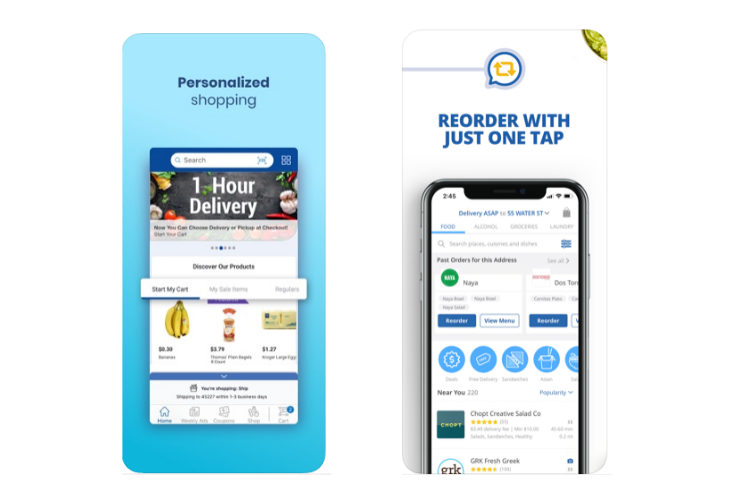
Figure 1: In application navigation
(Source: Created by the learner)
Effective signing up process
Examining the squad of famous applications for writing a plan, the small companies should search online some of them let consumers explore the operationality prior signing up. Post launching Instacart, the customers could include the Zip code and face what the companies are ready to provide for online deliveries and located nearby (Zhao, 2020).
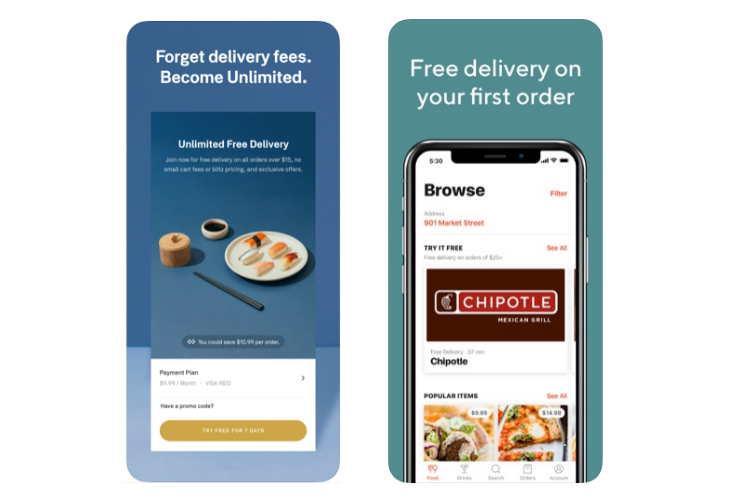
Figure 2: Signing up process
(Source: Created by the Learner)
The consumer panel look
- Users must be capable for effectively register on the proposed application. A consumer could simply login through filling the information, involving email, name, contact no. and location (Suk et al., 2020).
- The users could be able to browse their needed goods from a vast level of food items and grocery items.
- Consumers would be capable for applying specific filters to ensure the search effective and easy.
- Users would be capable for paying through the general and user-effective payment processes available in the country.
- The application will permit users to identify their preferred delivery times.
- The users will receive alerts through emails and SMS as well as the users could track real-time order information (Suk et al., 2020).
- Consumers would have an entire authority for modifying the settings that is they could change data like contact numbers, main addresses and others
- The users could input their feedbacks for the goods they have purchased and store.
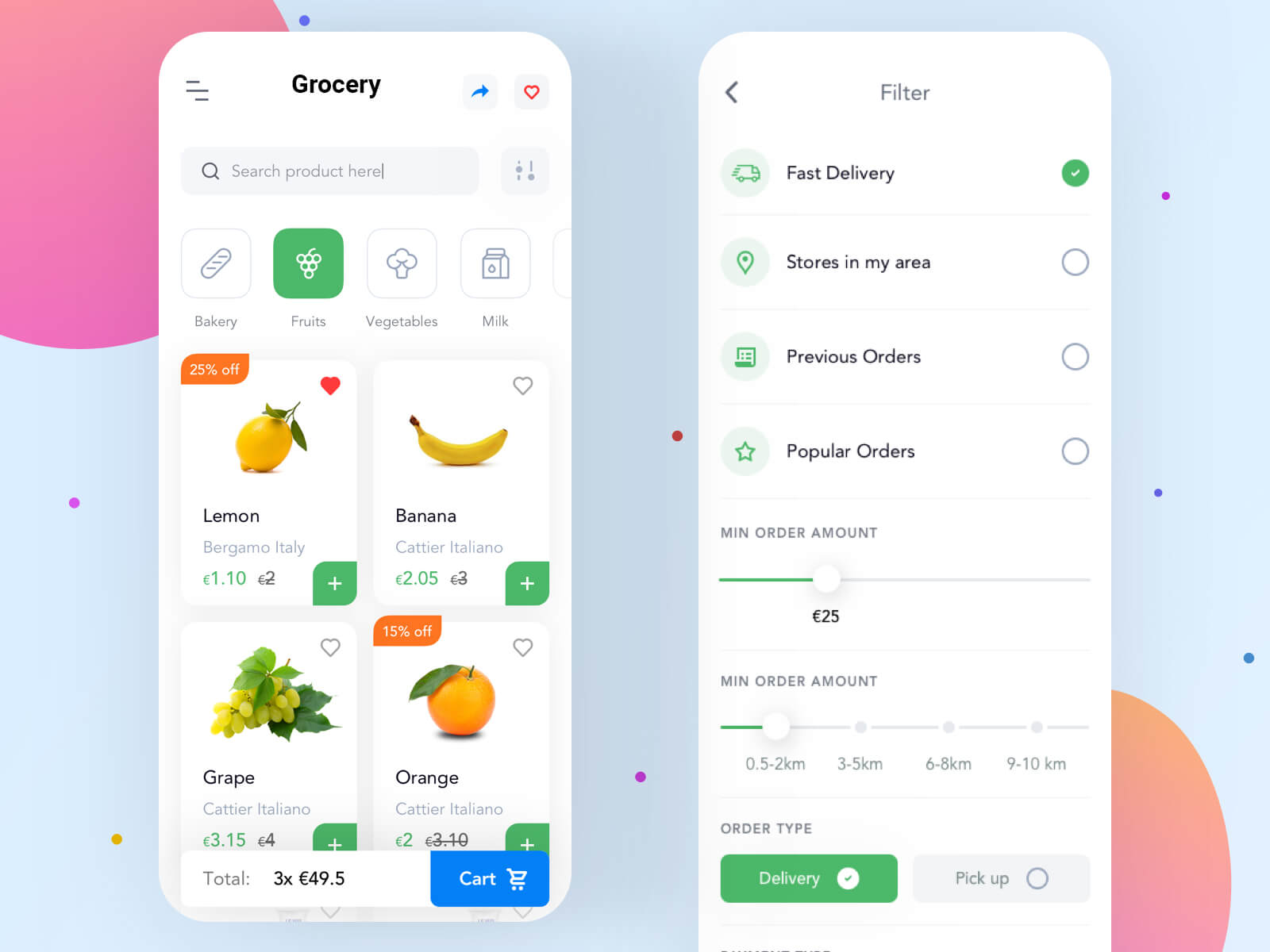
Figure 3: Consumer Panel Look
(Source: Sopow 2020)
Figure 3: consumer panel look (Source: Created by the learner)The company panel look
- Users will be capable to effectively register on the application. A consumer could simply need to login with the basic credentials that the company will ask for.
- The browse page information will be regularly updated by the company executives and sales persons
- The users could be able to search the delivery slots and delivery workers available on the company panel page (Belanche, Flavián & Pérez-Rueda, 2020). As the concern of hygiene has become important now, the page will update the workers’ status that the users could view.
- The spending report and the popular goods that consumers purchased in a day or in a week will be listed in the company panel page so that calculations and better stock of these products could be done on time.
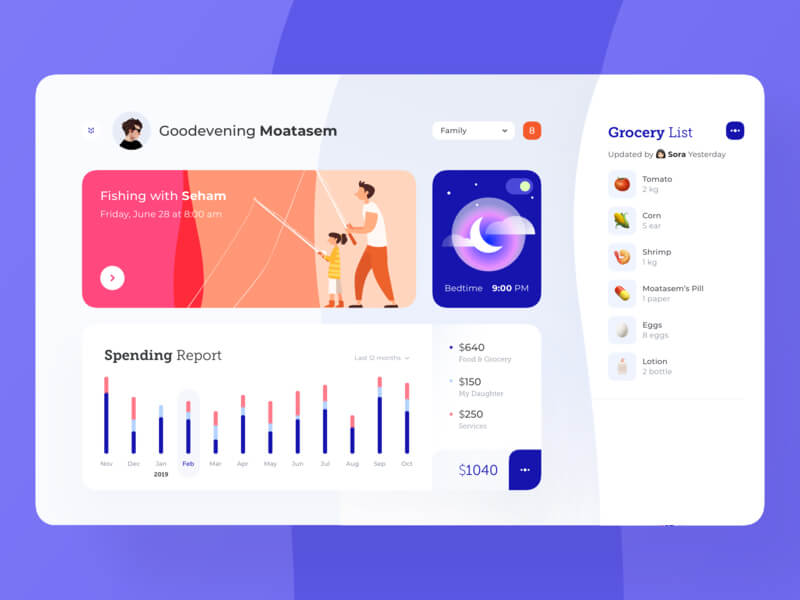
Figure 4: Company panel look
(Source: Created by the learner)
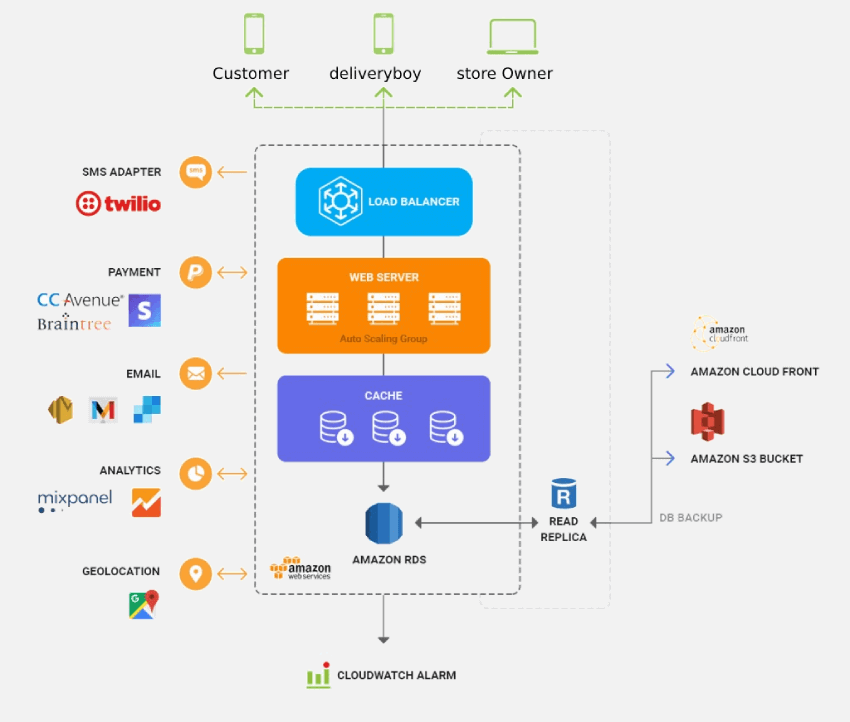
Figure 5: Mobile application architecture
(Source: Created by the learner)
Business model canvas
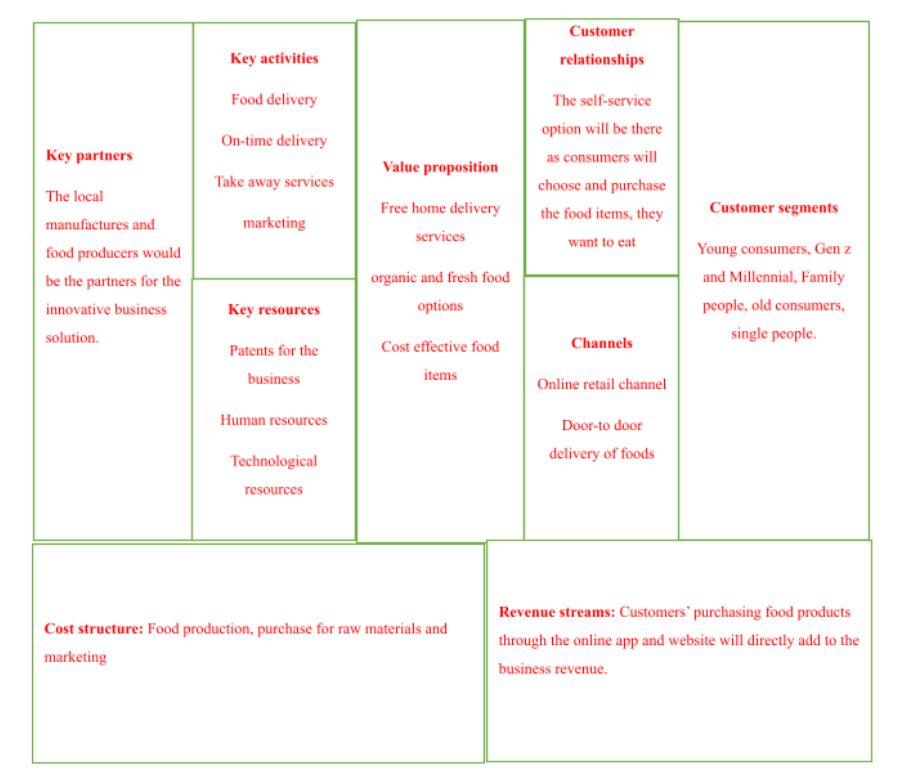
Table 6: Business model canvas for SMEs in the food and restaurant industry as per the innovative solution
(Source: Created by the learner))
Section 5. Key international considerations for implementation of the innovation overseas
The reconsiderations or factors important for application of the innovative proposal in Small and Medium sized companies in the restaurant industry in France are listed below;
Consumer behaviours in France in online grocery shopping
According to the market review currently, it could be said that French online consumers are generally considered as tech-savvy as well as confident in online purchasing. As users, they prefer respect, clear and updated data ad politeness with timely delivery of services. Around 80% of the French users compare prices prior purchasing the non-grocery items (Mehrolia, Alagarsamy & Solaikutty, 2020). Thus, if this type of innovative solutions the small and medium companies will apply in this country, they need to ensure two factors mostly, which are timely delivery at the locations and the information on the grocery stocks. On the other hand, the characteristic change is specifically pronounced among young consumers. The Gen-Z and Millennial customers around 35% cook meal from scratch over frequently than they did previously to the pandemic, as do around 23% of Gen-X and almost 17% of the baby boomers (Mehrolia, Alagarsamy & Solaikutty, 2020). Thus, targeting the young consumers could be more profitable for the small and medium companies.
Market competition for the SMEs
The increase of third-party and grocery and food delivery applications is one of the other important concern here. This kind of food purchasing has been specifically famous of late, led through effective brand identification for top players in the market with the brand-agnostic type of purchasing this offer (Verma, 2020). While technologically not a food delivery application such as Shipt or Instacart, this is effective to have goods delivered by the application. On the other hand, various big supermarket chains have also started increasing and marketing their own applications. All these changes are indicating to the fact that market competition will be rough and high in the French market for the SMEs to implement the innovative solution. In this regard, free shipping options and in-store pickup at determined time slots could be helpful for the small businesses (Jang, 2020). This will also help in minimizing the workers deficiencies.
Product category and concern of the French consumers
With the cost sensitivity of the users in the goods and food delivery applications, the concerns for fresh and healthy food categories are also higher in France. It has been reviewed that currently after the pandemic, many customers are shifting towards the fresh and healthy eating habits and searching for platforms that could offer healthy food options with the low costs and timely food deliveries as much as possible (Hwang, Kim & Lee, 2020). It could be said that Small and medium sized companies will need to stock the goods and food items as per the taste and preferences of the local consumers in France for more effectiveness.
Section 6: Challenges associated with implementing the innovative solution
- When any consumer registers on any online delivery website, the data they enter might not be true-thus, the companies could not know if they are truly interested in buying. For instance, cash-on-delivery buying created with fake phone number and location could outcome in huge loss in revenue. This is why, it is significant to do online recognition verification for every target consumer (Traka et al., 2020).
- Cyberattacks could include the safety for the online delivery app through impacting this with viruses as well as what is even bad, these might include the safety of the registered users’ information (Mann, 2020). External hackers could potentially increase access to the sensitive information, comprising credit card information. This challenge is one of the biggest matters for overcoming in the online delivery business and this is specifically of the largest problems of each online delivery owners.
- One of the main challenges, online delivery companies could face is the shopping cart rejection. Study showed that online users reject their shopping carts around 68% of the time and some companies could face rejection levels as higher as 80% (Annaraud & Berezina, 2020). Over 60% of online consumers look at the outlet’s return on policies prior making any purchasing (Traka et al., 2020). This could impact on the behaviours of the users and revenue of the company as well.
Section 7: Expected benefits to all stakeholders
This type of innovative solutions will have different impacts and benefit for the stakeholders of the small and medium sized companies (Belanche, Flavián & Pérez-Rueda, 2020). The consumers always will get the full benefit of buying what they want and the in any time they want. However, the safety and privacy matters would be the concern for the consumers always. Designers of the online applications will get benefit from selling the products and goods despite any physical store (Nagpal et al., 2020). This will directly add value to the business and help increasing revenue of the company. The online concern here is effective marketing tactic and gaining loyalty of the customers.
On the other hand, the small and medium sized businesses will face continuous consumer growth on the platforms and this will help them to minimize the losses they are facing currently due to lack of government back up funds and pandemic situations (Li, Mirosa & Bremer, 2020). Additionally, the online grocery and food delivery apps will work in developing the consumer engagement and online traffic generation for the small and medium sized companies in the local and domestic markets (Prajapati, Goswami & Agrawal, 2020).
Conclusion
From the above discussion, it has been understood that current pandemic situation has developed the market opportunities for the small and medium sized companies that are able to launch or shift their business online. The online delivery application is a helpful solution for the SMEs in the United Kingdom in the restaurant industry. The market environment in France as discussed is also favourable for the SMEs in restaurant and Café industry to operate through their online purchasing and selling app.
References
Annaraud, K., & Berezina, K. (2020). Predicting satisfaction and intentions to use online food delivery: What really makes a difference?. Journal of Foodservice Business Research, 1-19.
Belanche, D., Flavián, M., & Pérez-Rueda, A. (2020). Mobile Apps Use and WOM in the Food Delivery Sector: The Role of Planned Behavior, Perceived Security and Customer Lifestyle Compatibility. Sustainability, 12(10), 4275.
Belanche, D., Flavián, M., & Pérez-Rueda, A. (2020). Mobile Apps Use and WOM in the Food Delivery Sector: The Role of Planned Behavior, Perceived Security and Customer Lifestyle Compatibility. Sustainability, 12(10), 4275.
Brignall, M. (2020). Parcel delivery complaints treble amid UK's Covid online shopping boom. the Guardian. Retrieved 17 January 2021, from https://www.theguardian.com/business/2020/nov/16/parcel-delivery-complaints-treble-amid-uks-covid-online-shopping-boom.
Grashuis, J., Skevas, T., & Segovia, M. S. (2020). Grocery shopping preferences during the COVID-19 pandemic. Sustainability, 12(13), 5369.
Gunawan, H., Kusuma, A., & Abdullah, S. (2020). Parcel Locker as the Alternative of Parcel Delivery Service of Online Shopping. Journal of Computational and Theoretical Nanoscience, 17(2-3), 1311-1317.
Hayden, J. C., & Parkin, R. (2020). The challenges of COVID-19 for community pharmacists and opportunities for the future. Irish Journal of Psychological Medicine, 1-14. https://www2.deloitte.com/content/dam/Deloitte/uk/Documents/life-sciences-health-care/deloitte-uk-connected-health.pdf.
Www2.deloitte.com. (2021). Retrieved 17 January 2021, from https://www2.deloitte.com/content/dam/Deloitte/uk/Documents/life-sciences-health-care/deloitte-uk-connected-health.pdf.
Hussain, R., & Dawoud, D. M. (2020). Drive-thru pharmacy services: A way forward to combat COVID-19 pandemic. Research in Social and Administrative Pharmacy, 17(1), 1920-1924.
Hwang, J., Kim, J. J., & Lee, K. W. (2020). Investigating consumer innovativeness in the context of drone food delivery services: Its impact on attitude and behavioral intentions. Technological Forecasting and Social Change, 120433.
Injectable Drug Delivery. Smi-online.co.uk. (2021). Retrieved 17 January 2021, from https://www.smi-online.co.uk/pharmaceuticals/uk/conference/injectable-drug-delivery
.Jang, W. J. (2020). A Study on Current Status and Prospects of Global Food-tech Industry. Journal of the Korea Convergence Society, 11(4), 247-254.
Kim, J. (2020). Analysis for Growth Potential in Response to Changes in the Online Food Market. Sustainability, 12(11), 4386.
Li, C., Mirosa, M., & Bremer, P. (2020). Review of Online Food Delivery Platforms and their Impacts on Sustainability. Sustainability, 12(14), 5528.
Li, C., Mirosa, M., & Bremer, P. (2020). Review of Online Food Delivery Platforms and their Impacts on Sustainability. Sustainability, 12(14), 5528.
Mann, A. (2020). Hacking the Foodscape: Digital Communication in the Co-design of Sustainable and Inclusive Food Environments. In The Local and the Digital in Environmental Communication (pp. 183-202). Palgrave Macmillan, Cham.
Mehrolia, S., Alagarsamy, S., & Solaikutty, V. M. (2020). Customers response to online food delivery services during COVID?19 outbreak using binary logistic regression. International Journal of Consumer Studies.
Nagpal, M., Kansal, K., Chopra, A., Gautam, N., & Jain, V. K. (2020). Effective Approach for Sentiment Analysis of Food Delivery Apps. In Soft Computing: Theories and Applications (pp. 527-536). Springer, Singapore.
Prajapati, B., Goswami, A., & Agrawal, A. (2020). A Study on Social Media as a promotional tool for Food Ordering Companies and its impact on customers. Volume 8, Issue 3 March 2020 | ISSN: 2320-2882
Shahmohammadi, S., Steinmann, Z. J., Tambjerg, L., van Loon, P., King, J. H., & Huijbregts, M. A. (2020). Comparative Greenhouse Gas Footprinting of Online versus Traditional Shopping for Fast-Moving Consumer Goods: A Stochastic Approach. Environmental science & technology, 54(6), 3499-3509.
Shveda, K. (2020). How Covid-19 is changing food shopping. Bbc.com. Retrieved 17 January 2021, from https://www.bbc.com/future/bespoke/follow-the-food/how-covid-19-is-changing-food-shopping.html.
Singh, S., Kumar, R., Panchal, R., & Tiwari, M. K. (2020). Impact of COVID-19 on logistics systems and disruptions in food supply chain. International Journal of Production Research, 1-16.
Suk, J., Yang, Y. J., Jeong, Y. J., Xiang, M., & Kim, K. O. (2020, February). Consumer Experience of a Disruptive Technology: An O2O Food Delivery App Case. In International Conference on Intelligent Human Systems Integration (pp. 1171-1177). Springer, Cham.
Traka, M. H., Plumb, J., Berry, R., Pinchen, H., & Finglas, P. M. (2020). Maintaining and updating food composition datasets for multiple users and novel technologies: Current challenges from a UK perspective. Nutrition Bulletin, 45(2), 230-240.
Verma, P. (2020). The effect of presentation, product availability and ease upon transaction reliability for online food delivery aggregator applications–moderated mediated model. Journal of Foodservice Business Research, 1-20.
Wickware, C. (2020). Pandemic medicines delivery service expected to end on 31 July 2020, says pharmacy representative body. Pharmaceutical Journal. Retrieved 17 January 2021, from https://www.pharmaceutical-journal.com/news-and-analysis/news/pandemic-medicines-delivery-service-expected-to-end-on-31-july-2020-says-pharmacy-representative-body/20208099.article.
Wu, C., Jiang, P., Li, W., Guo, H., Wang, J., Chen, J., ... & Wang, Z. L. (2020). Self?Powered Iontophoretic Transdermal Drug Delivery System Driven and Regulated by Biomechanical Motions. Advanced Functional Materials, 30(3), 1907378.
Zhao, Y. (2020, June). Design Of App Ui Based On Gustatory Visualization-Focus On Delivery App. In 2020 5th International Conference on Smart Grid and Electrical Automation (ICSGEA) (pp. 480-484). IEEE.
Zhou, M., Zhao, L., Kong, N., Campy, K. S., Xu, G., Zhu, G., ... & Wang, S. (2020). Understanding consumers’ behavior to adopt self-service parcel services for last-mile delivery. Journal of Retailing and Consumer Services, 52, 101911.












